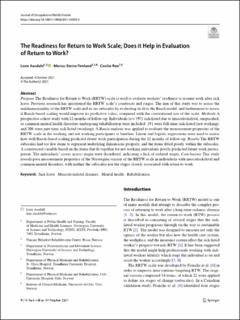| dc.contributor.author | Aasdahl, Lene | |
| dc.contributor.author | Fimland, Marius Steiro | |
| dc.contributor.author | Røe, Cecilie | |
| dc.date.accessioned | 2021-10-26T06:22:34Z | |
| dc.date.available | 2021-10-26T06:22:34Z | |
| dc.date.created | 2021-10-25T13:17:42Z | |
| dc.date.issued | 2021 | |
| dc.identifier.citation | Journal of occupational rehabilitation. 2021, | en_US |
| dc.identifier.issn | 1053-0487 | |
| dc.identifier.uri | https://hdl.handle.net/11250/2825484 | |
| dc.description.abstract | Purpose The Readiness for Return to Work (RRTW) scale is used to evaluate workers’ readiness to resume work after sick leave. Previous research has questioned the RRTW scale’s constructs and stages. The aim of this study was to assess the unidimensionality of the RRTW scale and its six subscales by evaluating its fit to the Rasch model, and furthermore to assess if Rasch-based scaling would improve its predictive value, compared with the conventional use of the scale. Methods A prospective cohort study with 12 months of follow-up. Individuals (n = 397) sick-listed due to musculoskeletal, unspecified, or common mental health disorders undergoing rehabilitation were included: 191 were full-time sick-listed (not working), and 206 were part-time sick-listed (working). A Rasch analysis was applied to evaluate the measurement properties of the RRTW scale in the working and not working participants at baseline. Linear and logistic regressions were used to assess how well Rasch-based scaling predicted future work participation during the 12 months of follow-up. Results The RRTW subscales had too few items to represent underlying dimensions properly, and the items fitted poorly within the subscales. A constructed variable based on the items that fit together for not working individuals poorly predicted future work participation. The individuals’ scores across stages were disordered, indicating a lack of ordered stages. Conclusions This study reveals poor measurement properties of the Norwegian version of the RRTW scale in individuals with musculoskeletal and common mental disorders, with neither the subscales nor the stages closely associated with return to work. | en_US |
| dc.language.iso | eng | en_US |
| dc.publisher | Springer Nature | en_US |
| dc.rights | Navngivelse 4.0 Internasjonal | * |
| dc.rights.uri | http://creativecommons.org/licenses/by/4.0/deed.no | * |
| dc.title | The Readiness for Return to Work Scale; Does it Help in Evaluation of Return to Work? | en_US |
| dc.type | Peer reviewed | en_US |
| dc.type | Journal article | en_US |
| dc.description.version | publishedVersion | en_US |
| dc.source.journal | Journal of occupational rehabilitation | en_US |
| dc.identifier.doi | https://doi.org/10.1007/s10926-021-10009-4 | |
| dc.identifier.cristin | 1948238 | |
| dc.relation.project | Norges forskningsråd: 238015 | en_US |
| cristin.ispublished | true | |
| cristin.fulltext | original | |
| cristin.qualitycode | 1 | |

